MIS782: IT Portfolio Theory - Value of Information at Gap Inc.
VerifiedAdded on 2023/06/13
|12
|2258
|353
Report
AI Summary
This report assesses Gap Inc.'s IT strategies through the lens of IT Portfolio Theory, focusing on how the company leverages IT assets to generate business value. It identifies key IT assets such as digitized inventory management, social media marketing, and Google Analytics, evaluating their impact on brand value and operational efficiency. The report also examines Gap's approach to risk and return within its IT portfolio, applying normative theory and analyzing both systematic and unsystematic risks. Furthermore, it employs a research-based view (RBV) to distinguish between tangible and intangible assets, highlighting the importance of brand reputation and intellectual property. The analysis concludes that a balanced approach to tangible and intangible assets is crucial for Gap to sustain its competitive advantage and enhance customer satisfaction, providing a comprehensive overview of IT's role in the company's overall business strategy. Desklib provides similar past papers and solved assignments for students.
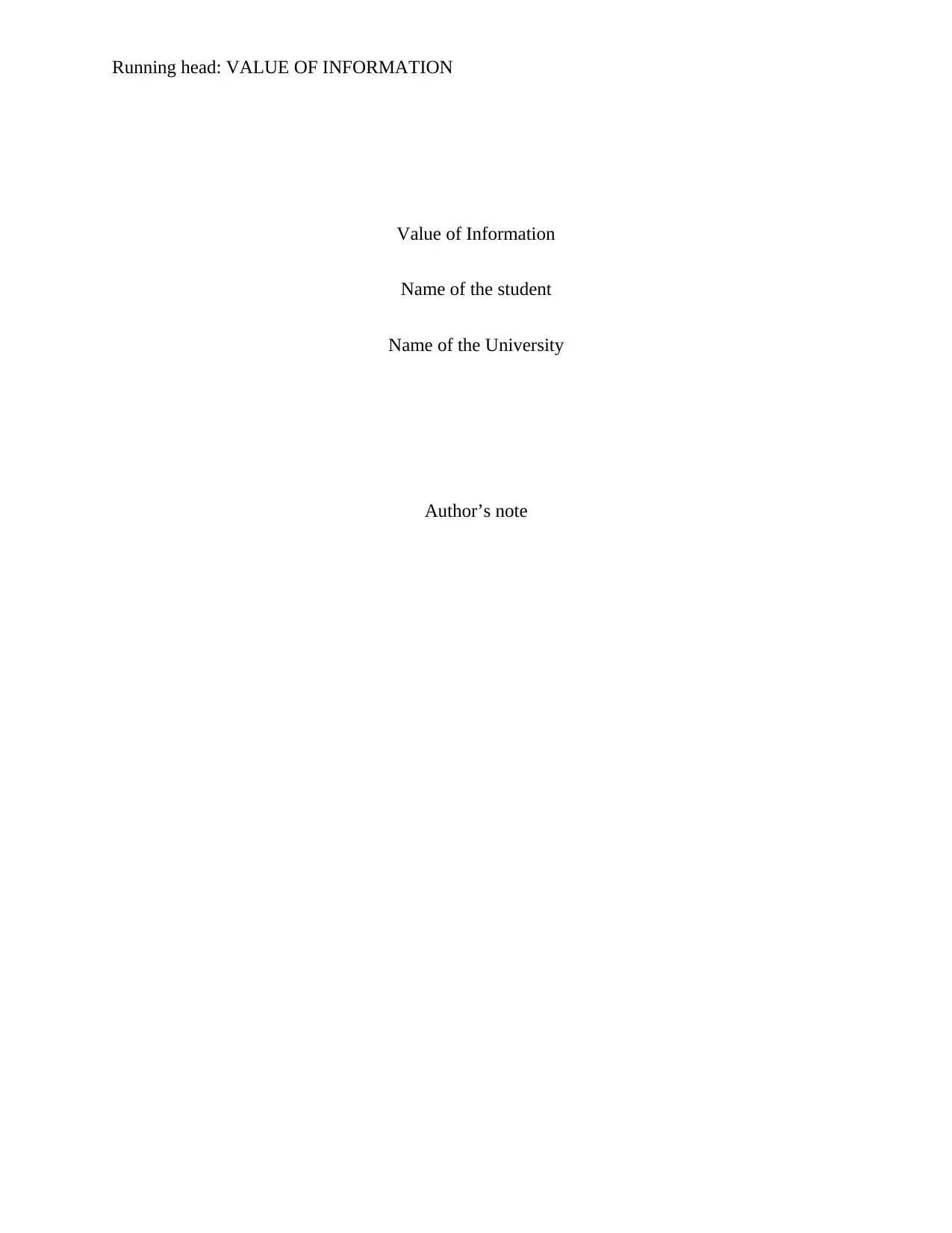
Running head: VALUE OF INFORMATION
Value of Information
Name of the student
Name of the University
Author’s note
Value of Information
Name of the student
Name of the University
Author’s note
Paraphrase This Document
Need a fresh take? Get an instant paraphrase of this document with our AI Paraphraser
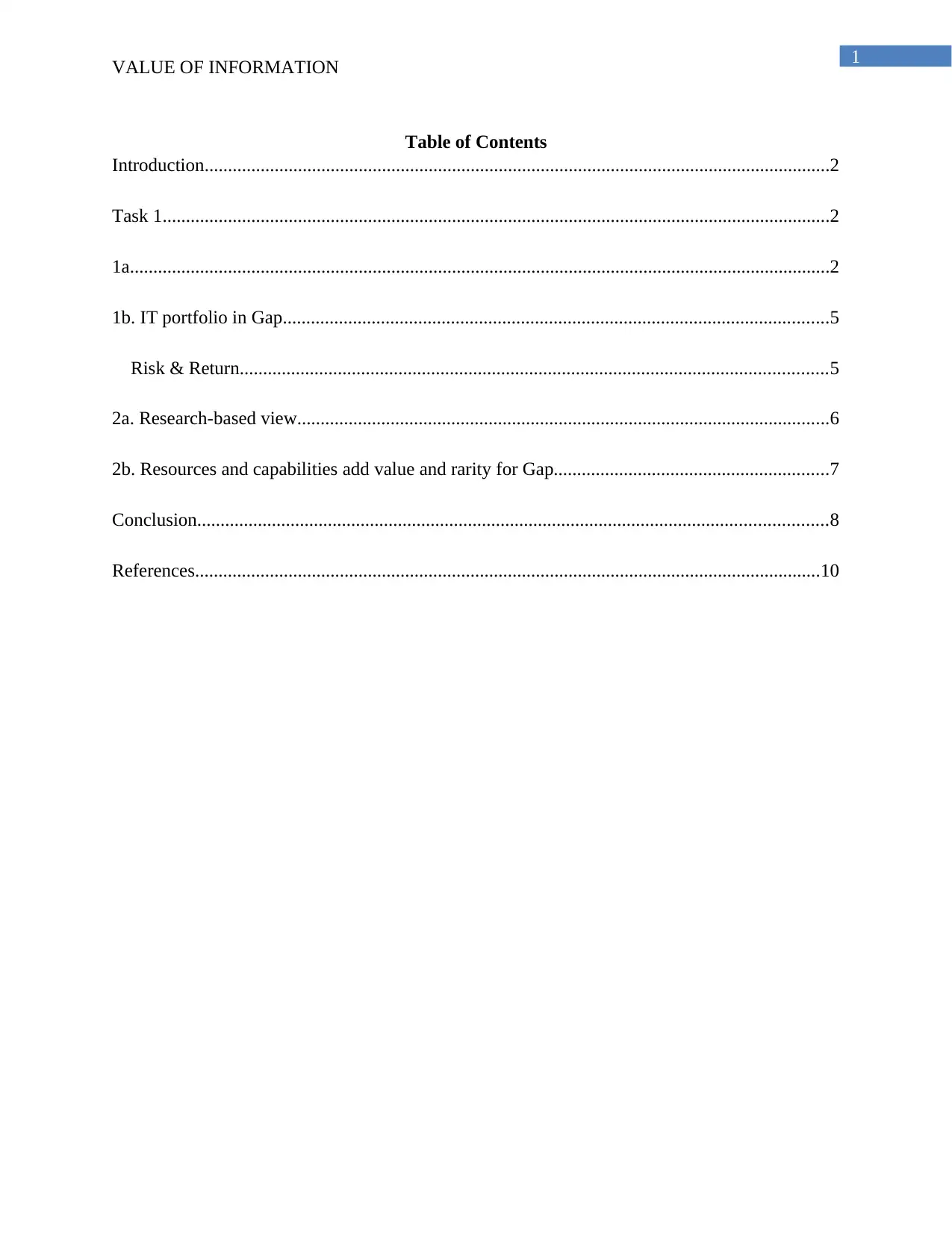
1
VALUE OF INFORMATION
Table of Contents
Introduction......................................................................................................................................2
Task 1...............................................................................................................................................2
1a......................................................................................................................................................2
1b. IT portfolio in Gap.....................................................................................................................5
Risk & Return..............................................................................................................................5
2a. Research-based view..................................................................................................................6
2b. Resources and capabilities add value and rarity for Gap...........................................................7
Conclusion.......................................................................................................................................8
References......................................................................................................................................10
VALUE OF INFORMATION
Table of Contents
Introduction......................................................................................................................................2
Task 1...............................................................................................................................................2
1a......................................................................................................................................................2
1b. IT portfolio in Gap.....................................................................................................................5
Risk & Return..............................................................................................................................5
2a. Research-based view..................................................................................................................6
2b. Resources and capabilities add value and rarity for Gap...........................................................7
Conclusion.......................................................................................................................................8
References......................................................................................................................................10
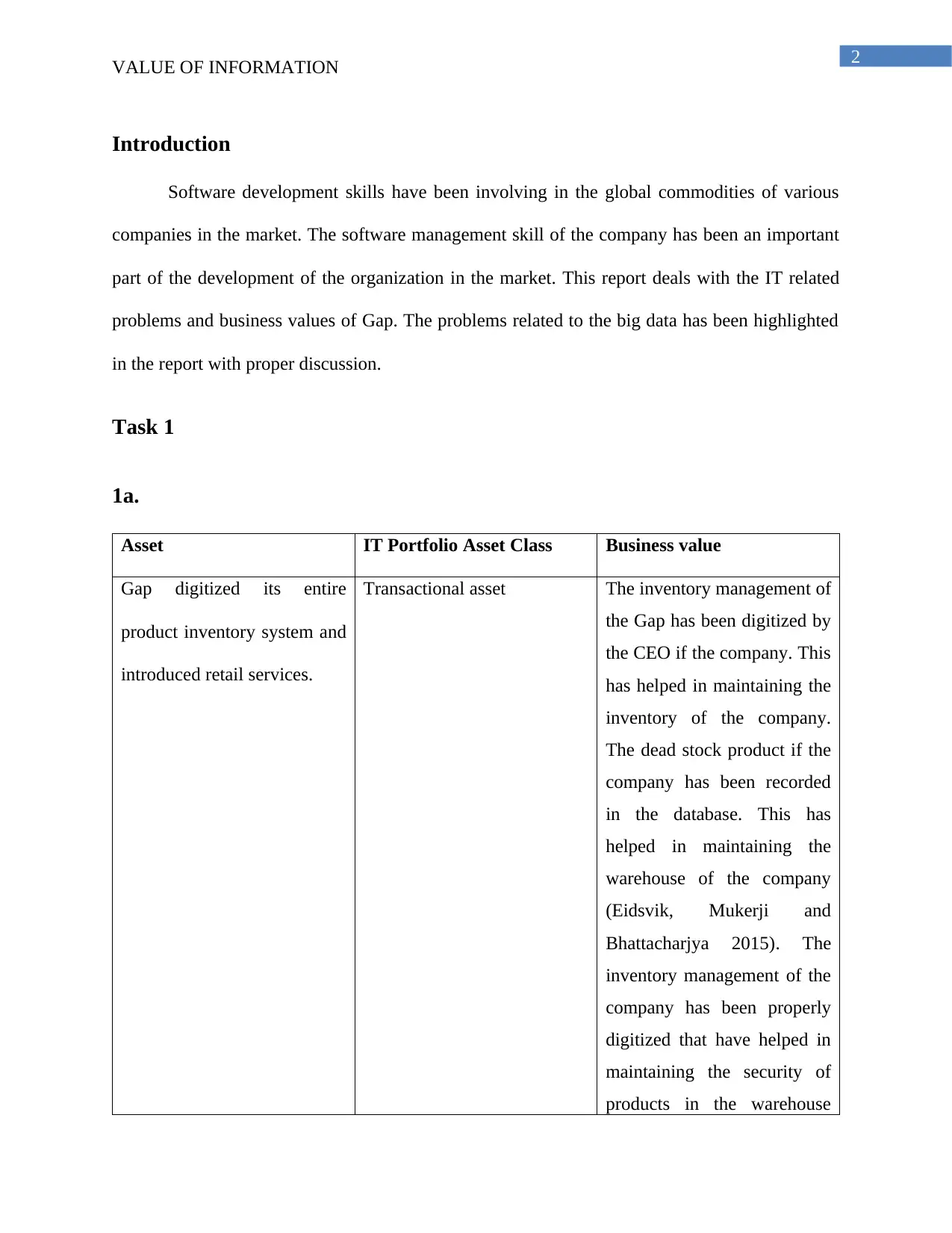
2
VALUE OF INFORMATION
Introduction
Software development skills have been involving in the global commodities of various
companies in the market. The software management skill of the company has been an important
part of the development of the organization in the market. This report deals with the IT related
problems and business values of Gap. The problems related to the big data has been highlighted
in the report with proper discussion.
Task 1
1a.
Asset IT Portfolio Asset Class Business value
Gap digitized its entire
product inventory system and
introduced retail services.
Transactional asset The inventory management of
the Gap has been digitized by
the CEO if the company. This
has helped in maintaining the
inventory of the company.
The dead stock product if the
company has been recorded
in the database. This has
helped in maintaining the
warehouse of the company
(Eidsvik, Mukerji and
Bhattacharjya 2015). The
inventory management of the
company has been properly
digitized that have helped in
maintaining the security of
products in the warehouse
VALUE OF INFORMATION
Introduction
Software development skills have been involving in the global commodities of various
companies in the market. The software management skill of the company has been an important
part of the development of the organization in the market. This report deals with the IT related
problems and business values of Gap. The problems related to the big data has been highlighted
in the report with proper discussion.
Task 1
1a.
Asset IT Portfolio Asset Class Business value
Gap digitized its entire
product inventory system and
introduced retail services.
Transactional asset The inventory management of
the Gap has been digitized by
the CEO if the company. This
has helped in maintaining the
inventory of the company.
The dead stock product if the
company has been recorded
in the database. This has
helped in maintaining the
warehouse of the company
(Eidsvik, Mukerji and
Bhattacharjya 2015). The
inventory management of the
company has been properly
digitized that have helped in
maintaining the security of
products in the warehouse
⊘ This is a preview!⊘
Do you want full access?
Subscribe today to unlock all pages.

Trusted by 1+ million students worldwide
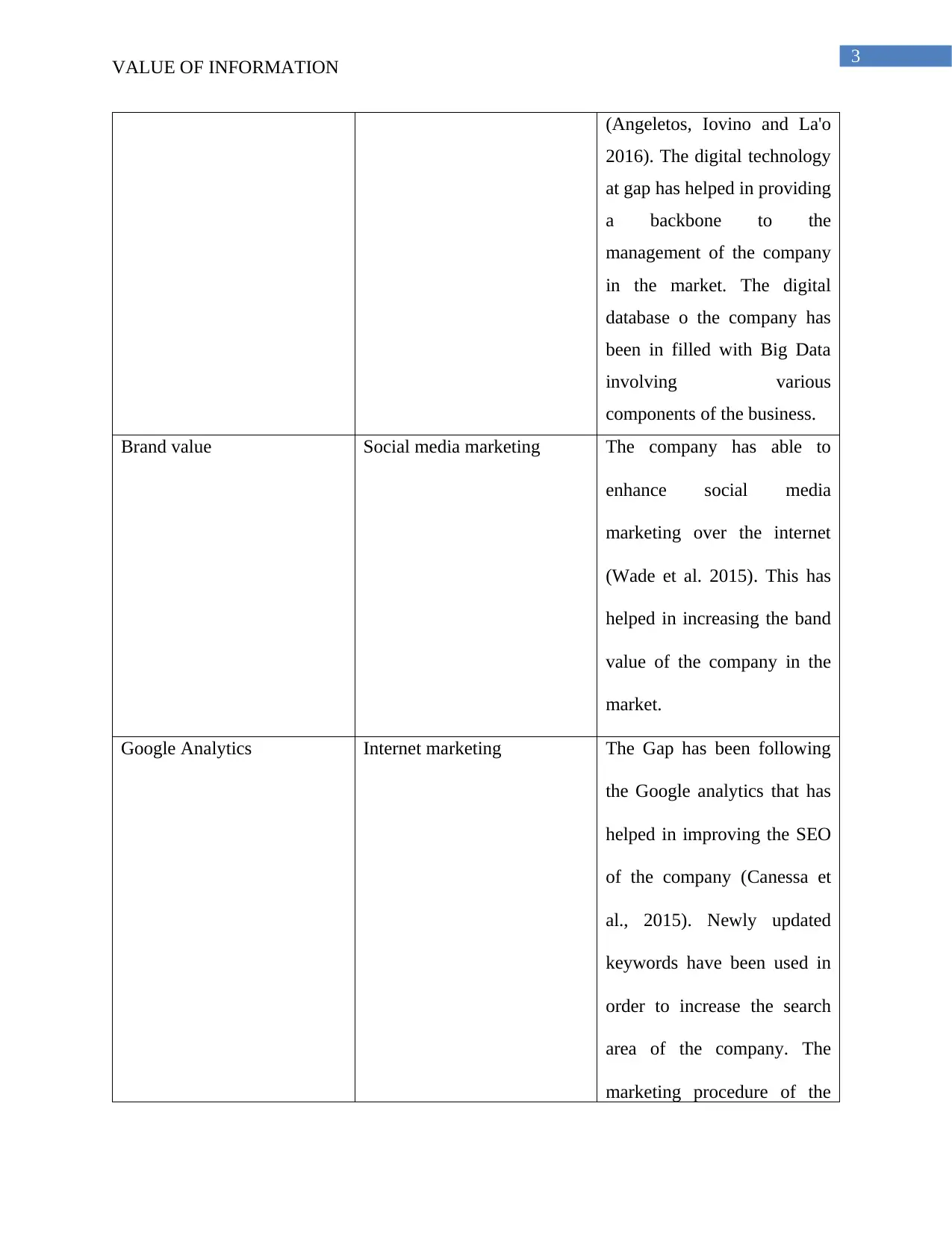
3
VALUE OF INFORMATION
(Angeletos, Iovino and La'o
2016). The digital technology
at gap has helped in providing
a backbone to the
management of the company
in the market. The digital
database o the company has
been in filled with Big Data
involving various
components of the business.
Brand value Social media marketing The company has able to
enhance social media
marketing over the internet
(Wade et al. 2015). This has
helped in increasing the band
value of the company in the
market.
Google Analytics Internet marketing The Gap has been following
the Google analytics that has
helped in improving the SEO
of the company (Canessa et
al., 2015). Newly updated
keywords have been used in
order to increase the search
area of the company. The
marketing procedure of the
VALUE OF INFORMATION
(Angeletos, Iovino and La'o
2016). The digital technology
at gap has helped in providing
a backbone to the
management of the company
in the market. The digital
database o the company has
been in filled with Big Data
involving various
components of the business.
Brand value Social media marketing The company has able to
enhance social media
marketing over the internet
(Wade et al. 2015). This has
helped in increasing the band
value of the company in the
market.
Google Analytics Internet marketing The Gap has been following
the Google analytics that has
helped in improving the SEO
of the company (Canessa et
al., 2015). Newly updated
keywords have been used in
order to increase the search
area of the company. The
marketing procedure of the
Paraphrase This Document
Need a fresh take? Get an instant paraphrase of this document with our AI Paraphraser
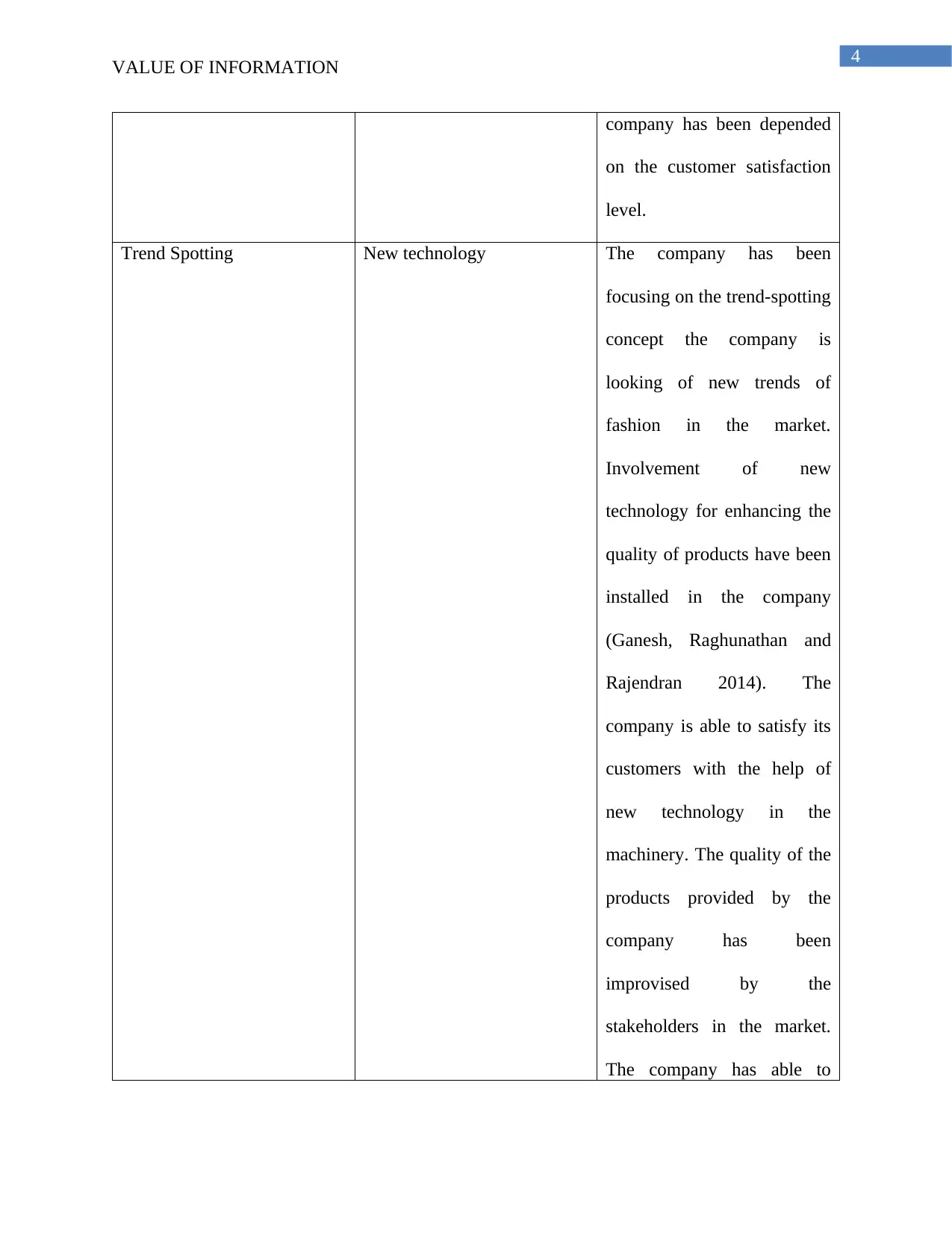
4
VALUE OF INFORMATION
company has been depended
on the customer satisfaction
level.
Trend Spotting New technology The company has been
focusing on the trend-spotting
concept the company is
looking of new trends of
fashion in the market.
Involvement of new
technology for enhancing the
quality of products have been
installed in the company
(Ganesh, Raghunathan and
Rajendran 2014). The
company is able to satisfy its
customers with the help of
new technology in the
machinery. The quality of the
products provided by the
company has been
improvised by the
stakeholders in the market.
The company has able to
VALUE OF INFORMATION
company has been depended
on the customer satisfaction
level.
Trend Spotting New technology The company has been
focusing on the trend-spotting
concept the company is
looking of new trends of
fashion in the market.
Involvement of new
technology for enhancing the
quality of products have been
installed in the company
(Ganesh, Raghunathan and
Rajendran 2014). The
company is able to satisfy its
customers with the help of
new technology in the
machinery. The quality of the
products provided by the
company has been
improvised by the
stakeholders in the market.
The company has able to
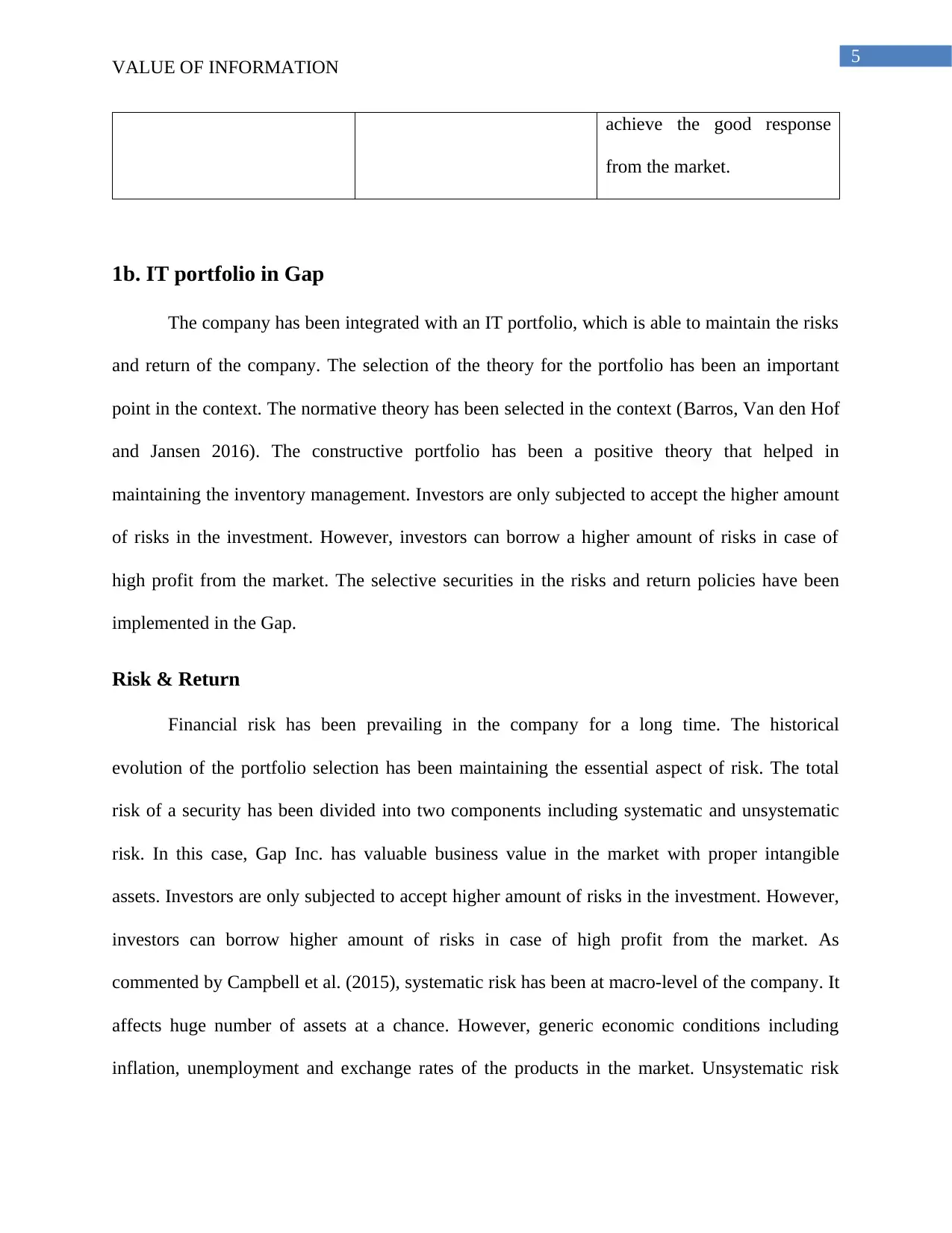
5
VALUE OF INFORMATION
achieve the good response
from the market.
1b. IT portfolio in Gap
The company has been integrated with an IT portfolio, which is able to maintain the risks
and return of the company. The selection of the theory for the portfolio has been an important
point in the context. The normative theory has been selected in the context (Barros, Van den Hof
and Jansen 2016). The constructive portfolio has been a positive theory that helped in
maintaining the inventory management. Investors are only subjected to accept the higher amount
of risks in the investment. However, investors can borrow a higher amount of risks in case of
high profit from the market. The selective securities in the risks and return policies have been
implemented in the Gap.
Risk & Return
Financial risk has been prevailing in the company for a long time. The historical
evolution of the portfolio selection has been maintaining the essential aspect of risk. The total
risk of a security has been divided into two components including systematic and unsystematic
risk. In this case, Gap Inc. has valuable business value in the market with proper intangible
assets. Investors are only subjected to accept higher amount of risks in the investment. However,
investors can borrow higher amount of risks in case of high profit from the market. As
commented by Campbell et al. (2015), systematic risk has been at macro-level of the company. It
affects huge number of assets at a chance. However, generic economic conditions including
inflation, unemployment and exchange rates of the products in the market. Unsystematic risk
VALUE OF INFORMATION
achieve the good response
from the market.
1b. IT portfolio in Gap
The company has been integrated with an IT portfolio, which is able to maintain the risks
and return of the company. The selection of the theory for the portfolio has been an important
point in the context. The normative theory has been selected in the context (Barros, Van den Hof
and Jansen 2016). The constructive portfolio has been a positive theory that helped in
maintaining the inventory management. Investors are only subjected to accept the higher amount
of risks in the investment. However, investors can borrow a higher amount of risks in case of
high profit from the market. The selective securities in the risks and return policies have been
implemented in the Gap.
Risk & Return
Financial risk has been prevailing in the company for a long time. The historical
evolution of the portfolio selection has been maintaining the essential aspect of risk. The total
risk of a security has been divided into two components including systematic and unsystematic
risk. In this case, Gap Inc. has valuable business value in the market with proper intangible
assets. Investors are only subjected to accept higher amount of risks in the investment. However,
investors can borrow higher amount of risks in case of high profit from the market. As
commented by Campbell et al. (2015), systematic risk has been at macro-level of the company. It
affects huge number of assets at a chance. However, generic economic conditions including
inflation, unemployment and exchange rates of the products in the market. Unsystematic risk
⊘ This is a preview!⊘
Do you want full access?
Subscribe today to unlock all pages.

Trusted by 1+ million students worldwide
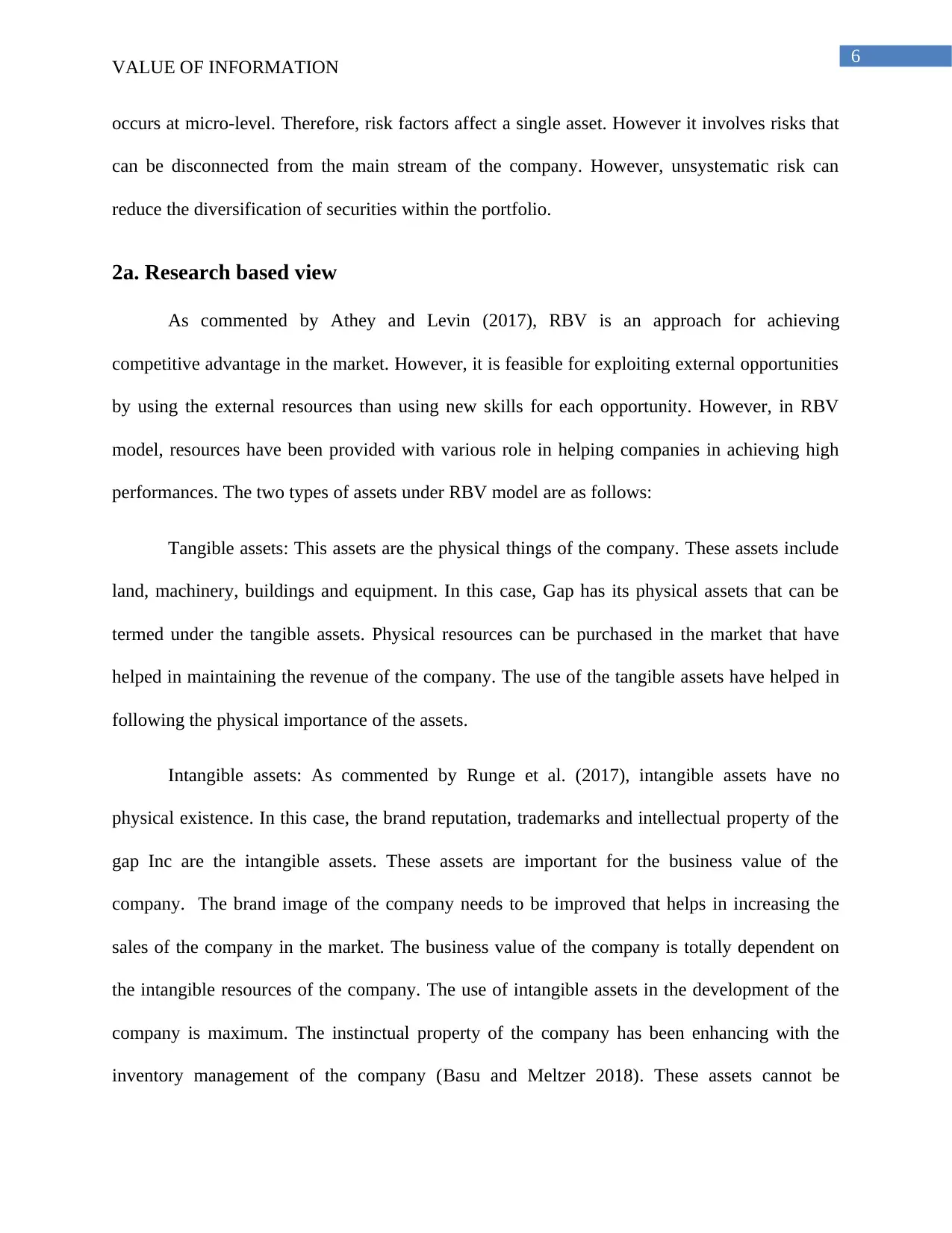
6
VALUE OF INFORMATION
occurs at micro-level. Therefore, risk factors affect a single asset. However it involves risks that
can be disconnected from the main stream of the company. However, unsystematic risk can
reduce the diversification of securities within the portfolio.
2a. Research based view
As commented by Athey and Levin (2017), RBV is an approach for achieving
competitive advantage in the market. However, it is feasible for exploiting external opportunities
by using the external resources than using new skills for each opportunity. However, in RBV
model, resources have been provided with various role in helping companies in achieving high
performances. The two types of assets under RBV model are as follows:
Tangible assets: This assets are the physical things of the company. These assets include
land, machinery, buildings and equipment. In this case, Gap has its physical assets that can be
termed under the tangible assets. Physical resources can be purchased in the market that have
helped in maintaining the revenue of the company. The use of the tangible assets have helped in
following the physical importance of the assets.
Intangible assets: As commented by Runge et al. (2017), intangible assets have no
physical existence. In this case, the brand reputation, trademarks and intellectual property of the
gap Inc are the intangible assets. These assets are important for the business value of the
company. The brand image of the company needs to be improved that helps in increasing the
sales of the company in the market. The business value of the company is totally dependent on
the intangible resources of the company. The use of intangible assets in the development of the
company is maximum. The instinctual property of the company has been enhancing with the
inventory management of the company (Basu and Meltzer 2018). These assets cannot be
VALUE OF INFORMATION
occurs at micro-level. Therefore, risk factors affect a single asset. However it involves risks that
can be disconnected from the main stream of the company. However, unsystematic risk can
reduce the diversification of securities within the portfolio.
2a. Research based view
As commented by Athey and Levin (2017), RBV is an approach for achieving
competitive advantage in the market. However, it is feasible for exploiting external opportunities
by using the external resources than using new skills for each opportunity. However, in RBV
model, resources have been provided with various role in helping companies in achieving high
performances. The two types of assets under RBV model are as follows:
Tangible assets: This assets are the physical things of the company. These assets include
land, machinery, buildings and equipment. In this case, Gap has its physical assets that can be
termed under the tangible assets. Physical resources can be purchased in the market that have
helped in maintaining the revenue of the company. The use of the tangible assets have helped in
following the physical importance of the assets.
Intangible assets: As commented by Runge et al. (2017), intangible assets have no
physical existence. In this case, the brand reputation, trademarks and intellectual property of the
gap Inc are the intangible assets. These assets are important for the business value of the
company. The brand image of the company needs to be improved that helps in increasing the
sales of the company in the market. The business value of the company is totally dependent on
the intangible resources of the company. The use of intangible assets in the development of the
company is maximum. The instinctual property of the company has been enhancing with the
inventory management of the company (Basu and Meltzer 2018). These assets cannot be
Paraphrase This Document
Need a fresh take? Get an instant paraphrase of this document with our AI Paraphraser
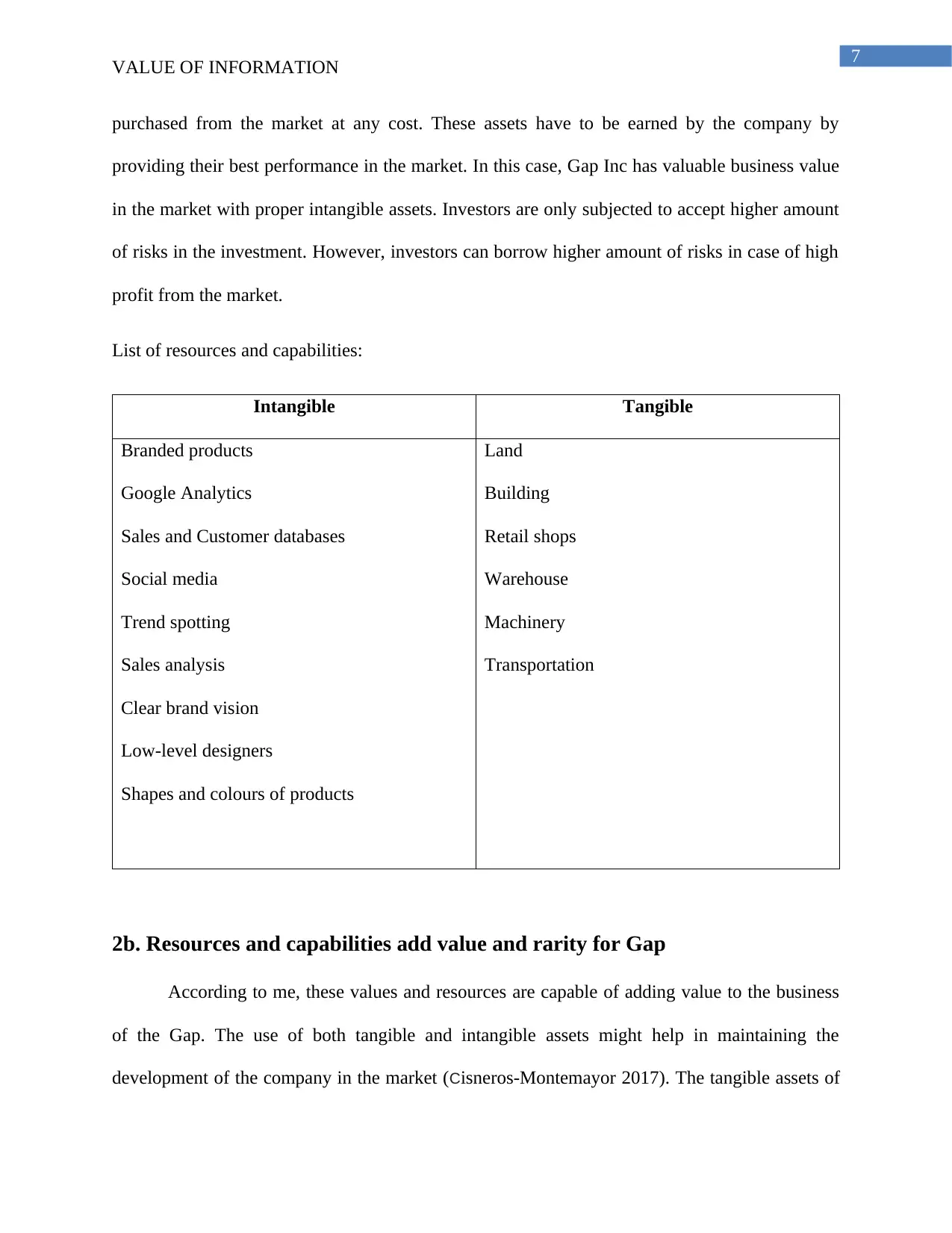
7
VALUE OF INFORMATION
purchased from the market at any cost. These assets have to be earned by the company by
providing their best performance in the market. In this case, Gap Inc has valuable business value
in the market with proper intangible assets. Investors are only subjected to accept higher amount
of risks in the investment. However, investors can borrow higher amount of risks in case of high
profit from the market.
List of resources and capabilities:
Intangible Tangible
Branded products
Google Analytics
Sales and Customer databases
Social media
Trend spotting
Sales analysis
Clear brand vision
Low-level designers
Shapes and colours of products
Land
Building
Retail shops
Warehouse
Machinery
Transportation
2b. Resources and capabilities add value and rarity for Gap
According to me, these values and resources are capable of adding value to the business
of the Gap. The use of both tangible and intangible assets might help in maintaining the
development of the company in the market (Cisneros-Montemayor 2017). The tangible assets of
VALUE OF INFORMATION
purchased from the market at any cost. These assets have to be earned by the company by
providing their best performance in the market. In this case, Gap Inc has valuable business value
in the market with proper intangible assets. Investors are only subjected to accept higher amount
of risks in the investment. However, investors can borrow higher amount of risks in case of high
profit from the market.
List of resources and capabilities:
Intangible Tangible
Branded products
Google Analytics
Sales and Customer databases
Social media
Trend spotting
Sales analysis
Clear brand vision
Low-level designers
Shapes and colours of products
Land
Building
Retail shops
Warehouse
Machinery
Transportation
2b. Resources and capabilities add value and rarity for Gap
According to me, these values and resources are capable of adding value to the business
of the Gap. The use of both tangible and intangible assets might help in maintaining the
development of the company in the market (Cisneros-Montemayor 2017). The tangible assets of
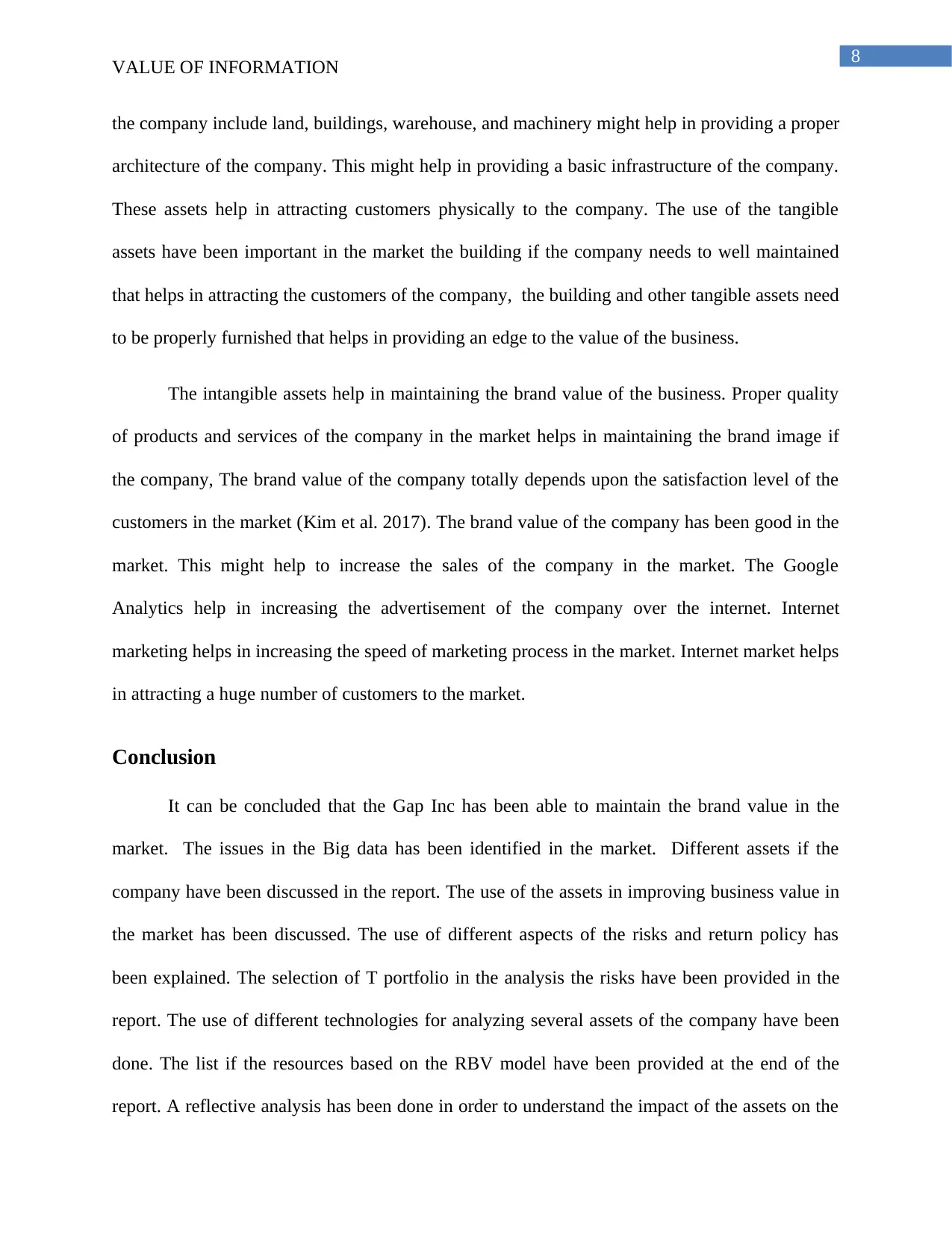
8
VALUE OF INFORMATION
the company include land, buildings, warehouse, and machinery might help in providing a proper
architecture of the company. This might help in providing a basic infrastructure of the company.
These assets help in attracting customers physically to the company. The use of the tangible
assets have been important in the market the building if the company needs to well maintained
that helps in attracting the customers of the company, the building and other tangible assets need
to be properly furnished that helps in providing an edge to the value of the business.
The intangible assets help in maintaining the brand value of the business. Proper quality
of products and services of the company in the market helps in maintaining the brand image if
the company, The brand value of the company totally depends upon the satisfaction level of the
customers in the market (Kim et al. 2017). The brand value of the company has been good in the
market. This might help to increase the sales of the company in the market. The Google
Analytics help in increasing the advertisement of the company over the internet. Internet
marketing helps in increasing the speed of marketing process in the market. Internet market helps
in attracting a huge number of customers to the market.
Conclusion
It can be concluded that the Gap Inc has been able to maintain the brand value in the
market. The issues in the Big data has been identified in the market. Different assets if the
company have been discussed in the report. The use of the assets in improving business value in
the market has been discussed. The use of different aspects of the risks and return policy has
been explained. The selection of T portfolio in the analysis the risks have been provided in the
report. The use of different technologies for analyzing several assets of the company have been
done. The list if the resources based on the RBV model have been provided at the end of the
report. A reflective analysis has been done in order to understand the impact of the assets on the
VALUE OF INFORMATION
the company include land, buildings, warehouse, and machinery might help in providing a proper
architecture of the company. This might help in providing a basic infrastructure of the company.
These assets help in attracting customers physically to the company. The use of the tangible
assets have been important in the market the building if the company needs to well maintained
that helps in attracting the customers of the company, the building and other tangible assets need
to be properly furnished that helps in providing an edge to the value of the business.
The intangible assets help in maintaining the brand value of the business. Proper quality
of products and services of the company in the market helps in maintaining the brand image if
the company, The brand value of the company totally depends upon the satisfaction level of the
customers in the market (Kim et al. 2017). The brand value of the company has been good in the
market. This might help to increase the sales of the company in the market. The Google
Analytics help in increasing the advertisement of the company over the internet. Internet
marketing helps in increasing the speed of marketing process in the market. Internet market helps
in attracting a huge number of customers to the market.
Conclusion
It can be concluded that the Gap Inc has been able to maintain the brand value in the
market. The issues in the Big data has been identified in the market. Different assets if the
company have been discussed in the report. The use of the assets in improving business value in
the market has been discussed. The use of different aspects of the risks and return policy has
been explained. The selection of T portfolio in the analysis the risks have been provided in the
report. The use of different technologies for analyzing several assets of the company have been
done. The list if the resources based on the RBV model have been provided at the end of the
report. A reflective analysis has been done in order to understand the impact of the assets on the
⊘ This is a preview!⊘
Do you want full access?
Subscribe today to unlock all pages.

Trusted by 1+ million students worldwide
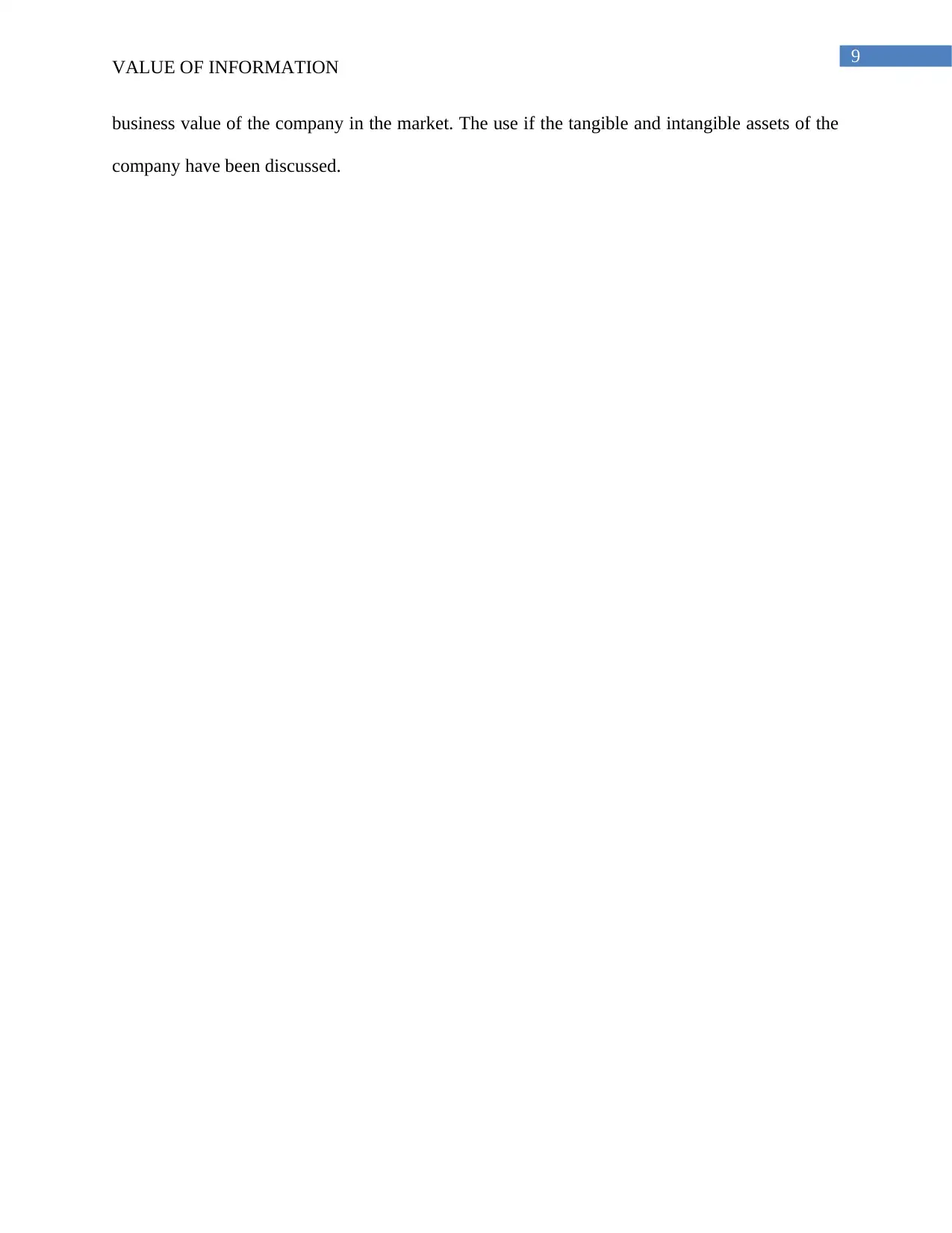
9
VALUE OF INFORMATION
business value of the company in the market. The use if the tangible and intangible assets of the
company have been discussed.
VALUE OF INFORMATION
business value of the company in the market. The use if the tangible and intangible assets of the
company have been discussed.
Paraphrase This Document
Need a fresh take? Get an instant paraphrase of this document with our AI Paraphraser
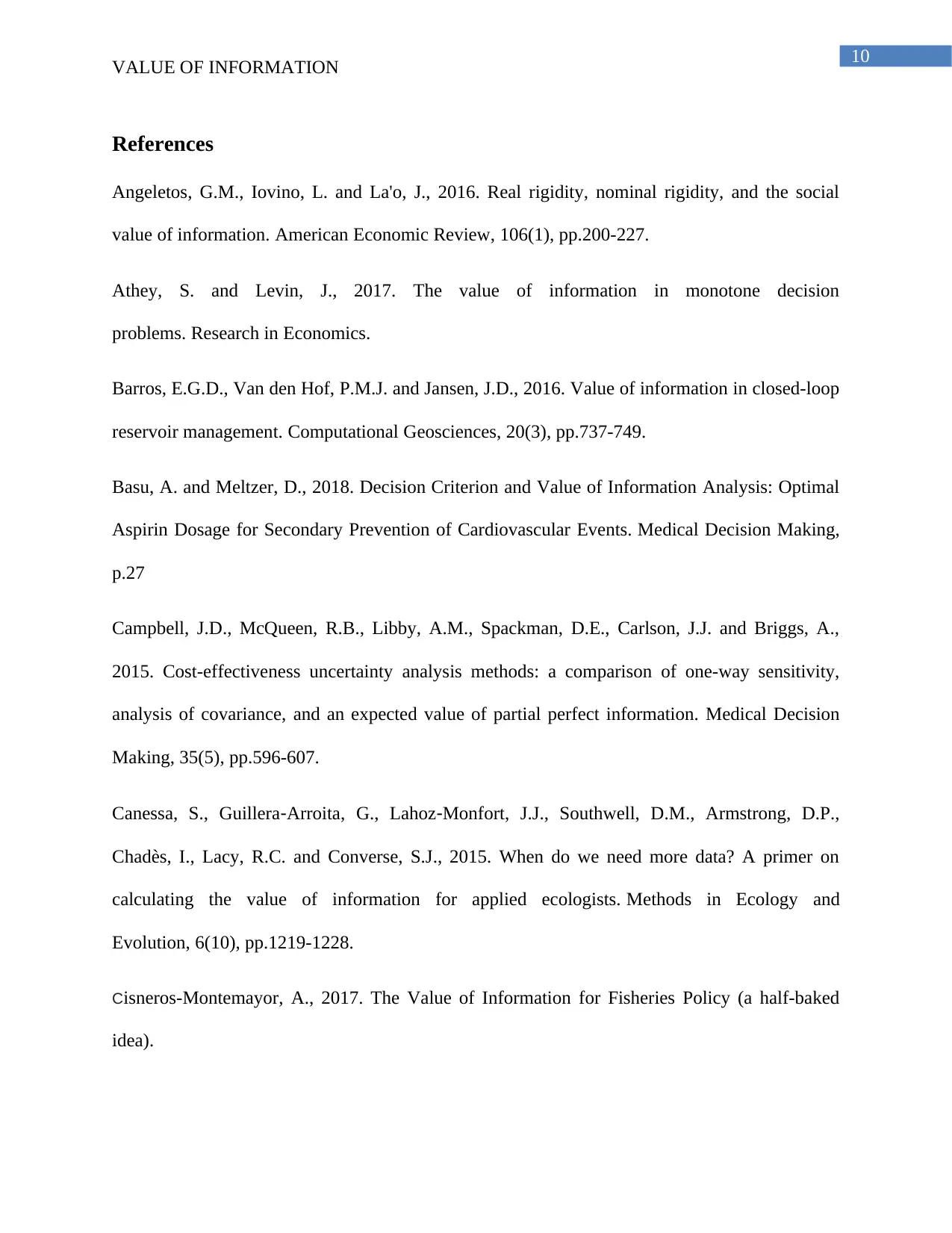
10
VALUE OF INFORMATION
References
Angeletos, G.M., Iovino, L. and La'o, J., 2016. Real rigidity, nominal rigidity, and the social
value of information. American Economic Review, 106(1), pp.200-227.
Athey, S. and Levin, J., 2017. The value of information in monotone decision
problems. Research in Economics.
Barros, E.G.D., Van den Hof, P.M.J. and Jansen, J.D., 2016. Value of information in closed-loop
reservoir management. Computational Geosciences, 20(3), pp.737-749.
Basu, A. and Meltzer, D., 2018. Decision Criterion and Value of Information Analysis: Optimal
Aspirin Dosage for Secondary Prevention of Cardiovascular Events. Medical Decision Making,
p.27
Campbell, J.D., McQueen, R.B., Libby, A.M., Spackman, D.E., Carlson, J.J. and Briggs, A.,
2015. Cost-effectiveness uncertainty analysis methods: a comparison of one-way sensitivity,
analysis of covariance, and an expected value of partial perfect information. Medical Decision
Making, 35(5), pp.596-607.
Canessa, S., Guillera‐Arroita, G., Lahoz‐Monfort, J.J., Southwell, D.M., Armstrong, D.P.,
Chadès, I., Lacy, R.C. and Converse, S.J., 2015. When do we need more data? A primer on
calculating the value of information for applied ecologists. Methods in Ecology and
Evolution, 6(10), pp.1219-1228.
Cisneros-Montemayor, A., 2017. The Value of Information for Fisheries Policy (a half-baked
idea).
VALUE OF INFORMATION
References
Angeletos, G.M., Iovino, L. and La'o, J., 2016. Real rigidity, nominal rigidity, and the social
value of information. American Economic Review, 106(1), pp.200-227.
Athey, S. and Levin, J., 2017. The value of information in monotone decision
problems. Research in Economics.
Barros, E.G.D., Van den Hof, P.M.J. and Jansen, J.D., 2016. Value of information in closed-loop
reservoir management. Computational Geosciences, 20(3), pp.737-749.
Basu, A. and Meltzer, D., 2018. Decision Criterion and Value of Information Analysis: Optimal
Aspirin Dosage for Secondary Prevention of Cardiovascular Events. Medical Decision Making,
p.27
Campbell, J.D., McQueen, R.B., Libby, A.M., Spackman, D.E., Carlson, J.J. and Briggs, A.,
2015. Cost-effectiveness uncertainty analysis methods: a comparison of one-way sensitivity,
analysis of covariance, and an expected value of partial perfect information. Medical Decision
Making, 35(5), pp.596-607.
Canessa, S., Guillera‐Arroita, G., Lahoz‐Monfort, J.J., Southwell, D.M., Armstrong, D.P.,
Chadès, I., Lacy, R.C. and Converse, S.J., 2015. When do we need more data? A primer on
calculating the value of information for applied ecologists. Methods in Ecology and
Evolution, 6(10), pp.1219-1228.
Cisneros-Montemayor, A., 2017. The Value of Information for Fisheries Policy (a half-baked
idea).
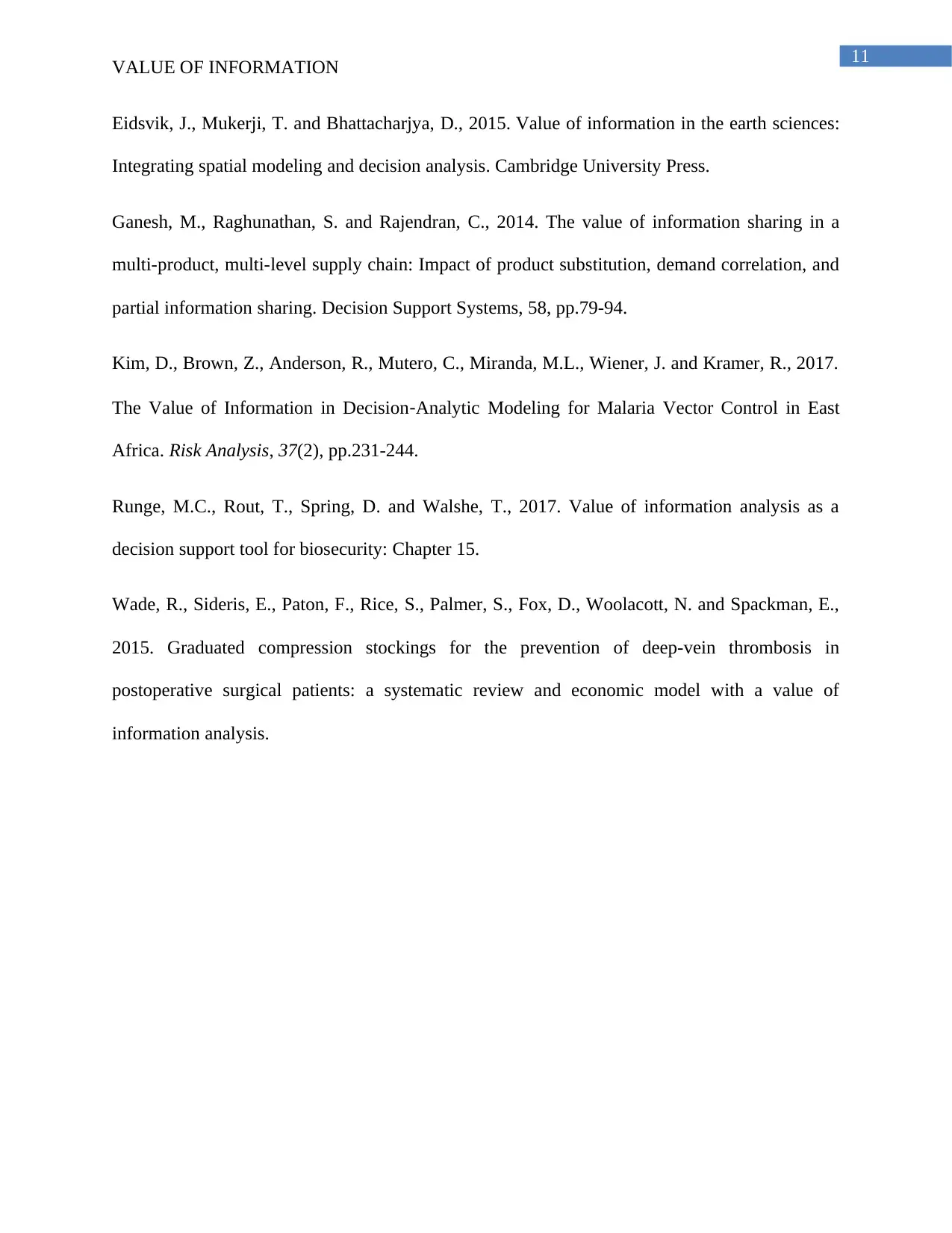
11
VALUE OF INFORMATION
Eidsvik, J., Mukerji, T. and Bhattacharjya, D., 2015. Value of information in the earth sciences:
Integrating spatial modeling and decision analysis. Cambridge University Press.
Ganesh, M., Raghunathan, S. and Rajendran, C., 2014. The value of information sharing in a
multi-product, multi-level supply chain: Impact of product substitution, demand correlation, and
partial information sharing. Decision Support Systems, 58, pp.79-94.
Kim, D., Brown, Z., Anderson, R., Mutero, C., Miranda, M.L., Wiener, J. and Kramer, R., 2017.
The Value of Information in Decision‐Analytic Modeling for Malaria Vector Control in East
Africa. Risk Analysis, 37(2), pp.231-244.
Runge, M.C., Rout, T., Spring, D. and Walshe, T., 2017. Value of information analysis as a
decision support tool for biosecurity: Chapter 15.
Wade, R., Sideris, E., Paton, F., Rice, S., Palmer, S., Fox, D., Woolacott, N. and Spackman, E.,
2015. Graduated compression stockings for the prevention of deep-vein thrombosis in
postoperative surgical patients: a systematic review and economic model with a value of
information analysis.
VALUE OF INFORMATION
Eidsvik, J., Mukerji, T. and Bhattacharjya, D., 2015. Value of information in the earth sciences:
Integrating spatial modeling and decision analysis. Cambridge University Press.
Ganesh, M., Raghunathan, S. and Rajendran, C., 2014. The value of information sharing in a
multi-product, multi-level supply chain: Impact of product substitution, demand correlation, and
partial information sharing. Decision Support Systems, 58, pp.79-94.
Kim, D., Brown, Z., Anderson, R., Mutero, C., Miranda, M.L., Wiener, J. and Kramer, R., 2017.
The Value of Information in Decision‐Analytic Modeling for Malaria Vector Control in East
Africa. Risk Analysis, 37(2), pp.231-244.
Runge, M.C., Rout, T., Spring, D. and Walshe, T., 2017. Value of information analysis as a
decision support tool for biosecurity: Chapter 15.
Wade, R., Sideris, E., Paton, F., Rice, S., Palmer, S., Fox, D., Woolacott, N. and Spackman, E.,
2015. Graduated compression stockings for the prevention of deep-vein thrombosis in
postoperative surgical patients: a systematic review and economic model with a value of
information analysis.
⊘ This is a preview!⊘
Do you want full access?
Subscribe today to unlock all pages.

Trusted by 1+ million students worldwide
1 out of 12
Related Documents
Your All-in-One AI-Powered Toolkit for Academic Success.
+13062052269
info@desklib.com
Available 24*7 on WhatsApp / Email
![[object Object]](/_next/static/media/star-bottom.7253800d.svg)
Unlock your academic potential
Copyright © 2020–2025 A2Z Services. All Rights Reserved. Developed and managed by ZUCOL.




